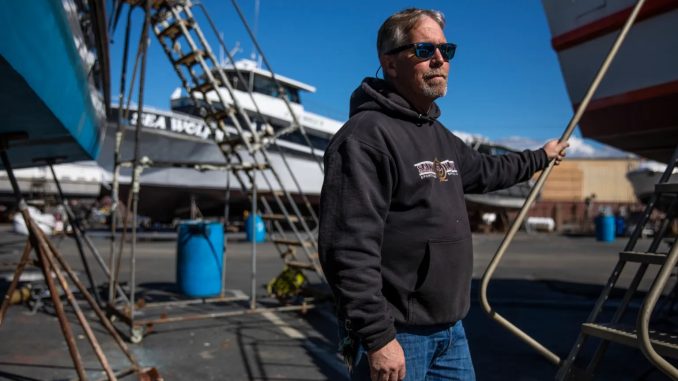
This story was produced by CalMatters, an independent public journalism venture covering California state politics and government. For more info, visit calmatters.org.
Most summer mornings at first light, Jared Davis is a few miles west of the Golden Gate Bridge, motoring his charter fishing boat Salty Lady over the Pacific Ocean. His eyes sweep the horizon, looking for diving birds, but mostly he watches the screen of his dashboard fish-finder for schools of anchovies—a sure sign that salmon are near. When the signs look good, he throttles down to trolling speed and tells his customers to let out their lines.
“Drop ‘em down!” Davis calls out the window. “Thirty to 40 feet!”
When the bite is steady, the Salty Lady may have 20 customers on board, each spending $200 for the chance to catch salmon. On the best days, fishing rods bend double the moment the lines go down, and a frenzy of action ensues, often amid a hundred or more other boats. Hooked Chinook thrash at the surface, and the deck becomes strewn with flopping fish.
Last year, California’s commercial and recreational fishing fleet, from the Central Coast to the Oregon border, landed about 300,000 salmon.
But this year, Davis and other salmon anglers won’t be fishing for salmon at all.
In response to crashing Chinook populations, a council of West Coast fishery managers plans to cancel this year’s salmon season in California, which will put hundreds of commercial fishermen and women out of work in Northern California and turn the summer into a bummer for thousands of recreational anglers.
Last year, the industry’s economic value was an estimated $460 million for fish sales and related businesses, including restaurants, tackle shops, private fishing guides, campgrounds and other services. Salmon season usually runs from May through October.
The closure, Davis said, “is going to be devastating to my business.” He said he will “try to scrape together a season” by targeting other species, like rockfish, lingcod, halibut and striped bass, but generating interest in catching these fish will be a challenge.
“Our customers want salmon,” he said, adding that last year, his customers caught roughly 2,000 Chinook.
Davis, 53, who has fished all his life, said the thrill of salmon fishing never grows old. “There’s nothing else like a wide-open salmon bite,” he said.
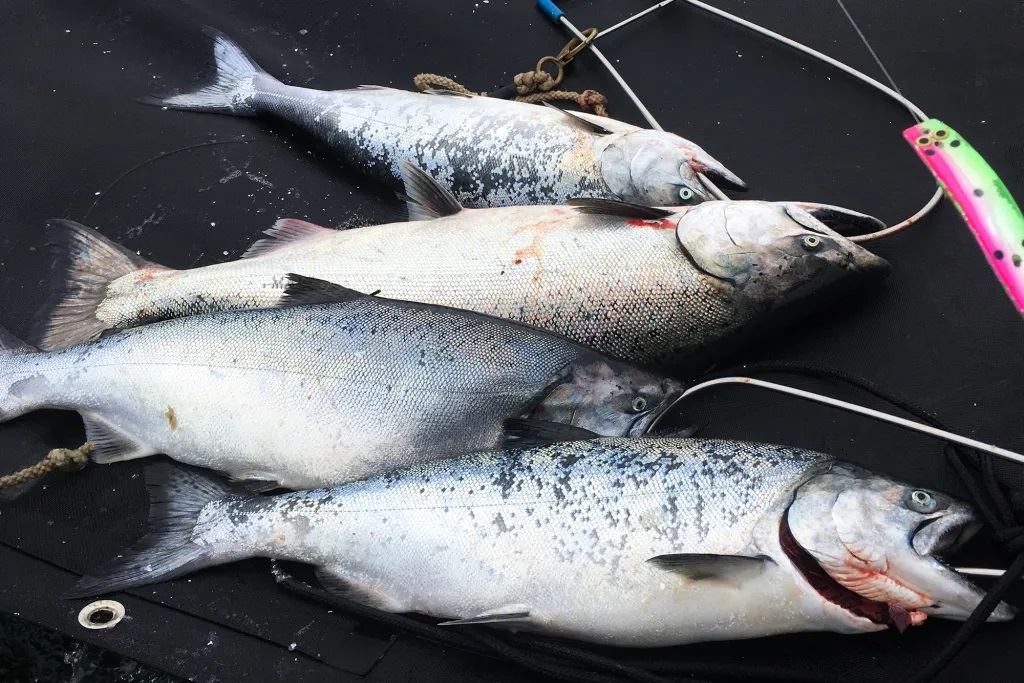
Only in two previous years—2008 and 2009—has California’s salmon season been shut down completely. That closure came as the numbers of spawning fish returning to the Sacramento River, the state’s main salmon producer, crashed to record lows.
Now California’s Chinook runs have collapsed again.
Just 62,000 adult fall-run Chinook returned last year to the Sacramento River to spawn, the third lowest return on record and only half of the fishery’s minimum target.
Runs on the Klamath River, in far-northern California, also have plunged, hitting 22,000 spawning adult fall-run Chinook last year, the fourth lowest return in 40 years. Native American tribes rely on the Klamath River’s salmon for traditional foods and ceremonies.
What’s ailing the fish, scientists and state officials say, is a variety of factors, primarily in the rivers where salmon spawn. Large volumes of water are diverted for use by farms and cities. Combined with drought, this causes low flows and high water temperatures, which can kill salmon eggs and young fish. Vast tracts of floodplains and wetlands, where small fish can find food and refuge, have also been lost to development and flood control projects.
Chuck Bonham, director of the California Department of Fish and Wildlife, said the quantity and quality of river water appear to drive salmon numbers.
“No doubt, water management is an issue, both allocation and delivery,” Bonham said.
Chinook in the Sacramento River have experienced almost complete spawning failures in the past several years. This has left a generational gap in the population that the fishing industry is now facing.
“We’re looking at the runs from the juveniles that went to sea three years ago, and these are the fish missing in action,” said Glen Spain, executive director of the Pacific Coast Federation of Fishermen’s Associations, which represents commercial fishers in 17 West Coast ports.
The collapse of salmon runs has stoked tensions between the fishing and agricultural communities.
“The real issue is the ability to divvy up a set amount of water between two different entities, fishermen and the farmers,” said Dick Ogg, a commercial fisherman in Bodega Bay.
‘Some of us will survive, some won’t’
The Pacific Fishery Management Council announced March 10 that it is choosing between three fishing season alternatives. Each would close the 2023 season, with the possibility of a reopening in 2024. The final decision will come during a session that begins April 1.
Many fishermen and women support the closure—despite the impact on their own finances—because there are too few salmon left to catch.
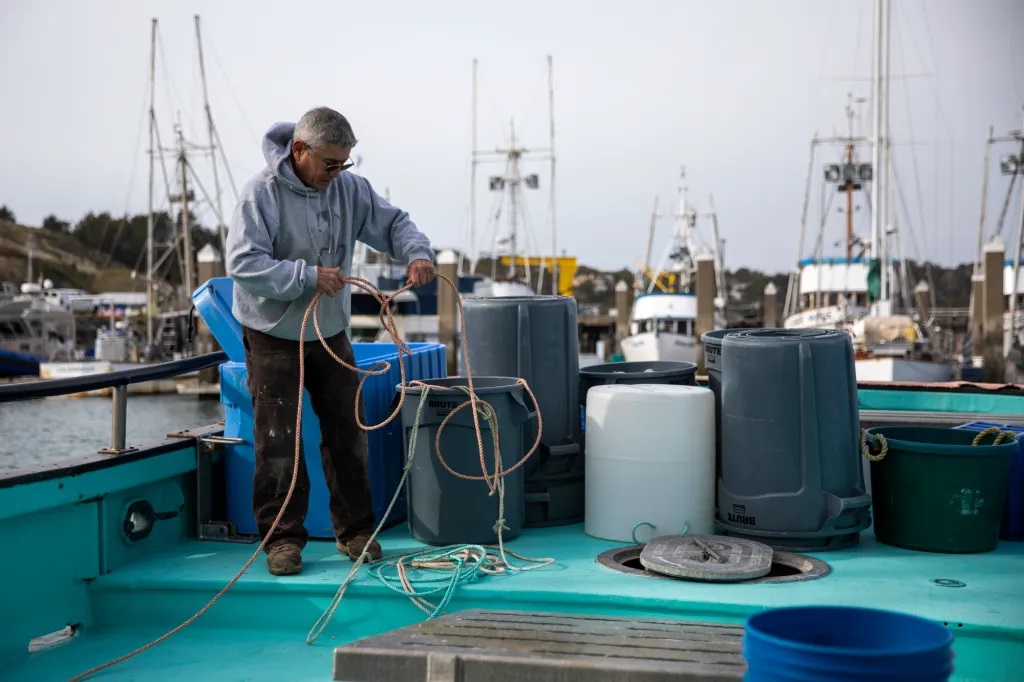
“We don’t have the abundance to support any harvest,” said Sarah Bates, of Oakland, who has fished commercially in coastal waters for 15 years.
Scientists estimate that 169,800 Sacramento River fall-run Chinook—the most abundant of the river’s four Chinook runs and the mainstay of the fishery—are now swimming off the coast. It’s the lowest estimated population since 2008.
Until the 1980s, California’s salmon boats routinely brought to port nearly a million fish per season. The record catch—1.4 million salmon—was in 1988. Recent years have seen catches of between 100,000 and 300,000.
As salmon populations have shrunk, California’s fishing fleet has shrunk, too. Nearly 5,000 commercial boats pursued California’s Chinook in the early 1980s. Now only 464 active boats are fishing commercially, according to the California Department of Fish and Wildlife. Plus, the state’s recreational anglers took about 98,000 trips last year and caught 89,000 salmon.
Still, a substantial salmon industry remains. A 2010 analysis estimated its worth at $344 million in direct fish sales and related economic activity. Cameron Speir, a U.S. National Marine Fisheries Service economist, said with inflation, that would bring the 2022 value to an estimated $460 million, although no formal estimates have been made.
The last time the fishing season was closed, fish businesses received federal disaster relief money, which is likely this year, too. Larry Collins, president of the San Francisco Community Fishing Association and formerly a salmon fisherman, said adequate compensation for the industry would amount to about $450 million. Getting it, he said, will require a plea to Congress.
Bates said a season closure will take away “the vast majority” of her annual income.
She said she can catch other fish to help make ends meet, though none of the other options—like rockfish, sablefish and halibut—provides the financial rewards that salmon fishing does.
“This will probably be pretty devastating for our local fleet,” she said. “Some of us will survive, some won’t.”
Kenny Belov, a wholesale fish supplier in San Francisco who bought 25,000 pounds of California Chinook last year, said no other local fish species commands more excitement than salmon.
“Salmon outsells everything,” said Belov, co-owner of TwoXSea.
But with a season closure imminent, Belov has already purchased futures in 31,000 pounds of yet-to-be-caught Alaskan coho. He expects to sell more salmon this summer than in previous years simply because Alaskan coho is cheaper than local Chinook, which is also called king salmon.
Eric Stockwell, a naturalist and ocean kayak fishing guide based in Humboldt County, said he wants a season closure even though it will put him out of work. He called it long overdue, given the recurring poor returns in the Sacramento and Klamath rivers.
“It’s a shame seasons have been allowed even though we haven’t reached the minimum escapement spawning goals,” Stockwell said.
Fishing, after all, has impacts on the salmon population, too.
Last summer, California’s commercial salmon fishers had an unexpectedly good year, catching two to three times more fish than managers expected. If the overall population is as low as scientists think it is, that harvest took a big chunk from the population when it was already down.
‘Without salmon, we are not Yurok people’
For many Californians, wild Chinook salmon is a rare treat. For members of California’s indigenous tribes, it is a core element of their culture and diet.
In the Klamath River basin, the Karuk, Hoopa and Yurok tribes fish for Chinook salmon for subsistence.
“The health of our people depends on having salmon,” said Bill Tripp, the Karuk Tribe’s director of natural resources and environmental policy. “Their survival in the basin is imperative. If they disappear, we could lose our ability to survive here.”
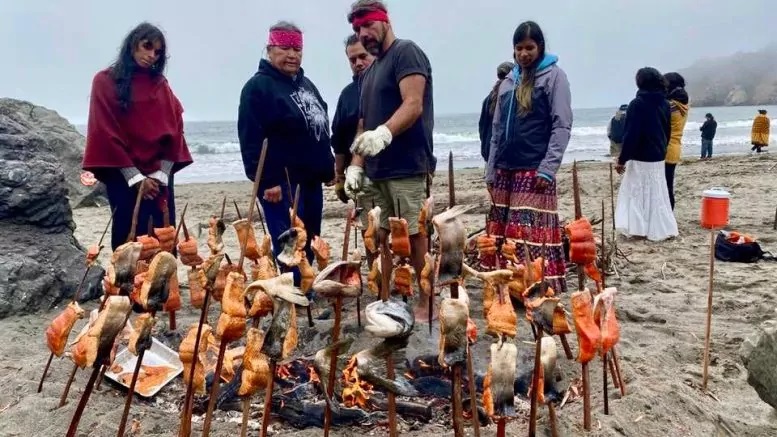
Tribes set their own catch limits, but they tend to reflect the population estimates of the Pacific Fishery Management Council, according to Barry McCovey Jr., who directs the Yurok’s fisheries program.
In 2017—a bad year for Klamath salmon—the Yurok forfeited their subsistence catch, taking just a handful of salmon for traditional ceremonies. This year’s allocation has not yet been set, but McCovey said it will probably be another meager season for the tribes.
The Karuk, who live along the middle-lower reaches of the Klamath River, traditionally fished for salmon using dip nets.
Downstream, toward the river’s mouth, McCovey learned to fish with his father in the 1980s and ‘90s. At the time, he said, catching salmon—whether using traditional gillnets or rod-and-reel—was relatively easy.
“Salmon were pretty abundant then,” McCovey said. Teaching his own children to fish is more challenging. “It’s a lot harder to catch salmon now,” he said.
McCovey said the Klamath once supported a million spawning Chinook each year. Now, he said, “we’re lucky if we get 100,000.”
Dams built long ago block salmon from reaching their historic spawning grounds. Agricultural diversions compete with salmon, reducing flows to lukewarm trickles that cause massive fish kills.
To McCovey, the decline is an existential threat.
“Without salmon, we are not Yurok people,” he said.
Ebb and flow of droughts
Historically as many as 2 million Chinook may have spawned most years in the Sacramento and San Joaquin rivers and another 2 million salmon, including coho, probably spawned annually in the Klamath, Russian, Eel, Smith and other coastal rivers and streams. Steelhead trout thrived in these watersheds, too.
With the arrival of European Americans, salmon populations began to decline. Industrial gold mining denuded mountain sides and clogged rivers with mud in the 1850s, destroying habitat and causing heavy losses to salmon runs. Dams built in the 20th century blocked the fish from reaching their spawning grounds altogether, wiping out the San Joaquin River’s Chinook.
Now the salmon are left dependent on human intervention: Gravel is dumped in rivers to replicate mountain spawning grounds, cold water is released from the depths of reservoirs and millions of baby salmon are produced in hatcheries to supplement failing wild runs. Often young fish are trucked to San Francisco Bay for release, which helps them escape the dangerous water pumps of the Delta.
These measures, at least for a time, worked reasonably well to support the fishery. Between 200,000 and 400,000 fish, or more, spawned each year through much of the post-dam era—but no longer.
Droughts, which reduce spawning success, also pose a recurring threat. Dry years are often followed by a dip in numbers of adult salmon in the ocean a lifespan later, about three years.
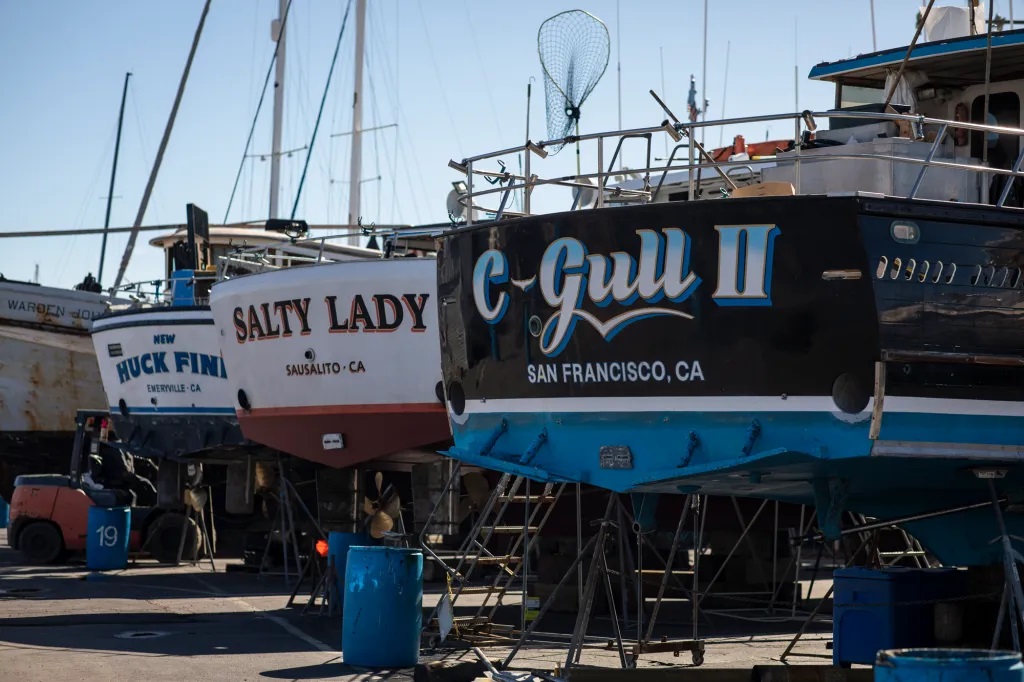
The converse, said Fish and Wildlife’s Bonham, is also true: “When you have wetter years, you see the numbers jump up three years later.”
For instance, a dramatic spike in 2002 that reached almost 900,000 fall-run Chinook in the Central Valley followed a period of exceptionally wet years in the late 1990s.
If water means fish, this year’s wet winter, now shaping into a record-setter, could boost survival among salmon juveniles migrating to the ocean and lead to more adult fish in a few years.
“I hope to see them doing at least somewhat better in a few years,” said Chris Shutes, executive director of the California Sportfishing Protection Alliance.
Marc Gorelnik, chair of the Pacific Fishery Management Council, said California’s Chinook have weathered droughts before, even emerging from the epic 1987-92 drought in relatively good shape. But, he said, the population at the time, including fish in the ocean, was six to eight times the current estimate.
“Our biggest challenge in management now is that we have so few fish to work with,” Gorelnik said.
At least two years in a row, nearly all eggs of endangered winter-run Chinook laid and fertilized in the Sacramento River have died. Many eggs have perished in lethally warm water. And an emerging threat— thiamine deficiency, which may be linked to shifting patterns in the ocean food web driven by climate change—has killed many more. Fishery advocates see little reason to think the fall-run Chinook fared much better.
Looking forward
Restoring depleted salmon runs is a goal that, along much of the West Coast, has eluded resource managers while bristling tensions between competing users of water. Some researchers feel it’s an almost hopeless endeavor, incompatible with economic growth. A 2017 report from a team of California scientists predicted that many of the state’s native salmon and trout would vanish by 2070.
Hatchery production of baby fish could help avert the disappearance of salmon—why many anglers and commercial fishers want to see the Department of Fish and Wildlife ramp up its hatchery programs. Belov said he thinks the future of the state’s salmon fishery may depend less on restoring rivers and natural spawning habitat than on hatcheries.
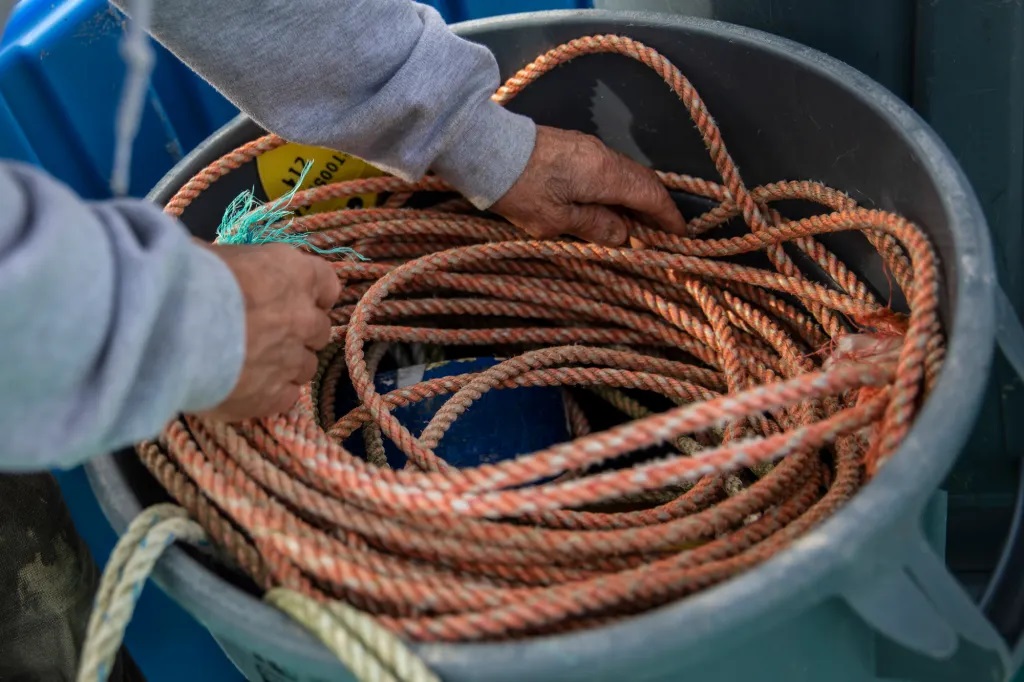
“If we’re going to keep growing food in the desert, then we might as well forget about wild salmon in California rivers,” Belov said. “The hatcheries need to work at 100 percent efficiency and put as many fish in the ocean for us to go catch.”
But on the Klamath, salmon advocates hope to rebuild naturally spawning populations. Four large dams are scheduled to be removed within the next two years. Tribes are helping direct the project, which will open up hundreds of miles of historic spawning habitat to salmon, potentially reviving the basin’s ailing runs.
Dams impounding the Central Valley’s rivers are unlikely ever to be removed, although state and federal biologists are helping Chinook repopulate the mountain tributaries upstream of Shasta Dam.
Some are optimistic about the potential for farms and fish to coexist.
“When in-river water conditions are adequate to allow the fish to return to the river to spawn and then, most importantly, wash the little fish out again, it’s still a really productive river system—definitely enough to support me and my family,” Bates said.
Spain of the fishermen’s association, though, fears things might get worse before they get better. So few fish spawned last year in the state’s major salmon rivers that “it means we can’t yet see a light at the end of this tunnel.”

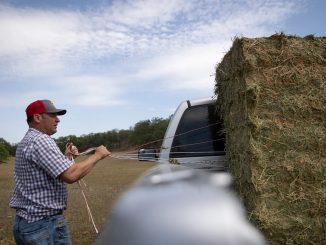
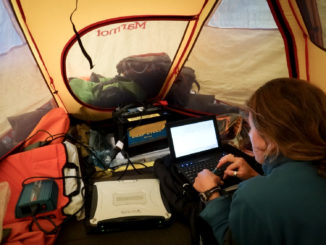

Be the first to comment